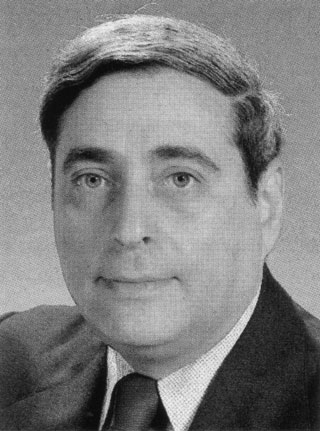
 |
Search | FAQ | US Titles | UK Titles | Memories | VaporWare | Digest | |||||||
| GuestBook | Classified | Chat | Products | Featured | Technical | Museum | ||||||||
| Downloads | Production | Fanfares | Music | Misc | Related | Contact | ||||||||
| Memories of VideoDisc - Who's Who in VideoDisc | ||||||||||||||

Fred Silverman received an MA in Television and Theater Arts from Ohio State University in 1961. Over the course of the next 20 years he worked at all three major networks in various capacities; first at CBS, then ABC, and finally three years as President of RCA subsidiary NBC. While at ABC, Silverman earned the nickname "the man with the golden gut," for his penchant of always selecting programming with high ratings. In December 1977, RCA chief Edgar Griffiths approached him about assuming the presidency of NBC in the hopes of shoring up it third-rate programming. Silverman came on board in June 1978, replacing Herbert Schlosser who was bumped up to a vice presidency at RCA where he soon became Executive Vice President of VideoDisc Programming.
But Fred Silverman lost his touch upon joining NBC with such disastrous shows as "Supertrain" and "Pink Lady and Jeff." He also clashed with NBC Chairwoman Jane Pfeiffer over programming issues. He left NBC at the same time as Edgar Griffiths officially stepped down at RCA, June 30, 1981, with Thornton Bradshaw assuming the RCA the following day. He was replaced by Grant Tinker in the NBC presidency. After leaving NBC, Silverman formed the Fred Silverman Company, an independent production company.
Fred Silverman devoted his life to programming television. He is the only person to have held key programming positions at all of the three traditional networks in the United States and today he owns the Fred Silverman Company, which produces programs for those networks. What makes Silverman unique in the history of American network television is that he raced through network jobs while still in his thirties and that his career mysteriously waned after having waxed so splendidly for so long.
Fred Silverman graduated with a Master's degree from Ohio State University (his master's thesis analyzed programming practices at ABC) and went to work for WGN-TV in Chicago to oversee children's programs. Soon, however, he moved to the network level. He assumed responsibility for daytime programming at CBS, where he later took charge of all of CBS Entertainment programming. During his tenure at CBS, Silverman remade the Saturday morning cartoon lineup and, in so doing, remade the ratings--from third to first. He also helped devise the programming strategy that brought All in the Family, The Mary Tyler Moore Show and The Waltons to CBS. With the success of the CBS schedule assured, Silverman moved on. In 1975, he became head of ABC Entertainment.
From 1975 to 1978, Fred Silverman took ABC from ratings parity with the other networks to ratings dominance over them. Among the shows and mini-series he was responsible for programming were Rich Man, Poor Man, Roots, Charlie's Angels and Starsky and Hutch. Silverman made the "third" network a ratings power and, as some of these program selections suggest, is credited with creating what critics called "jiggle TV," the type of television that features beautiful, scantily clad, frolicking women. In short, he bore partial responsibility for programming both acclaimed and reviled. But he demonstrated at ABC the same touch he had at CBS--an almost unerring sense of what the public, in great numbers, would watch on television. In 1977, a Time magazine cover story referred to Silverman as the "man with the golden gut," ostensibly referring to his unfailing programming instincts. At the height of his power at ABC, Silverman left to take on the presidency of NBC.
It was there, however, that whatever abilities brought him fame at the other two networks seemed to abandon Fred Silverman. Some of his program selections were disastrous, (Supertrain and Hello, Larry, an ill-conceived effort starring McLean Stevenson, formerly of M*A*S*H). Also, without the success he had enjoyed earlier, his mercurial behavior was less tolerable. After three difficult years, he was replaced at NBC by Grant Tinker. Fred Silverman's eighteen-year run with the networks was over.
Silverman left programming to make programs, but he did not enjoy immediate success. The first years for the Fred Silverman Company were difficult, particularly because the former program buyer was now forced to try to sell programming to many of the persons he had alienated at the networks. But in 1985, Silverman and partner Dean Hargrove produced the first Perry Mason movie with Raymond Burr. It was wildly successful and established the formula that would drive Silverman's comeback in television. He took identifiable television stars from the recent past and recast them in formulaic dramas. Andy Griffith in Matlock and Carroll O'Connor in In the Heat of the Night are but two examples. Silverman also used his programming acumen to push for favorable time slots for his shows. Because Silverman has enjoyed great success with his production company, some industry observers have called him the Nixon of television.
Throughout his career in network television, Silverman was considered a hero in the industry because he could devise program schedules that delivered strong ratings. But during the latter stages of his network years, some industry observers saw a danger in so much television programming having the imprimatur of one individual. Moreover, his critics often looked beyond the bottom line and lamented the content of the programming used to build Silverman's various ratings empires. His work at ABC has been particularly criticized because of messages regarding sex and violence in the programs. Television programming has been criticized for appealing to the lowest common denominator in its quest for raw numbers of viewers and more than once, Silverman has been targeted as the chief instrument of that appeal. Indeed, columnist Richard Reeves observed in 1978 that Silverman had probably done more to lower the standards of the viewing audience than any other individual.
Of Silverman's comeback, this much can be said--he returned to his roots. His productions, using familiar faces and formulas which have enjoyed prior television success, can be seen as part of a larger pattern. It has been suggested that one current programming trend is to look back to a time when network television was at its peak. In the face of a complex and mercurial telecommunications landscape, those involved in broadcasting seek comfort from a time more stable. Many of the programs meeting this need are revivals, retrospectives, or old faces in new attire. One need look no further than the "new" Burke's Law, Columbo, or Dick Van Dyke in Diagnosis: Murder. Silverman has capitalized on this tendency and has very probably become its leading practitioner. In a time when the term "auteur," or author, is being applied to television producers, the career of Fred Silverman suggests that an auteur could just as easily be the programmer as the program producer. For better or worse, few individuals have had as profound an impact on television programming for as long as Fred Silverman.
- The Encyclopedia of Television (1997 edition)
If you have some additional information to supply on Freddy Silverman, feel free to submit the form below, so your comments can be added to this page.
Send your comments in email via the Contact page